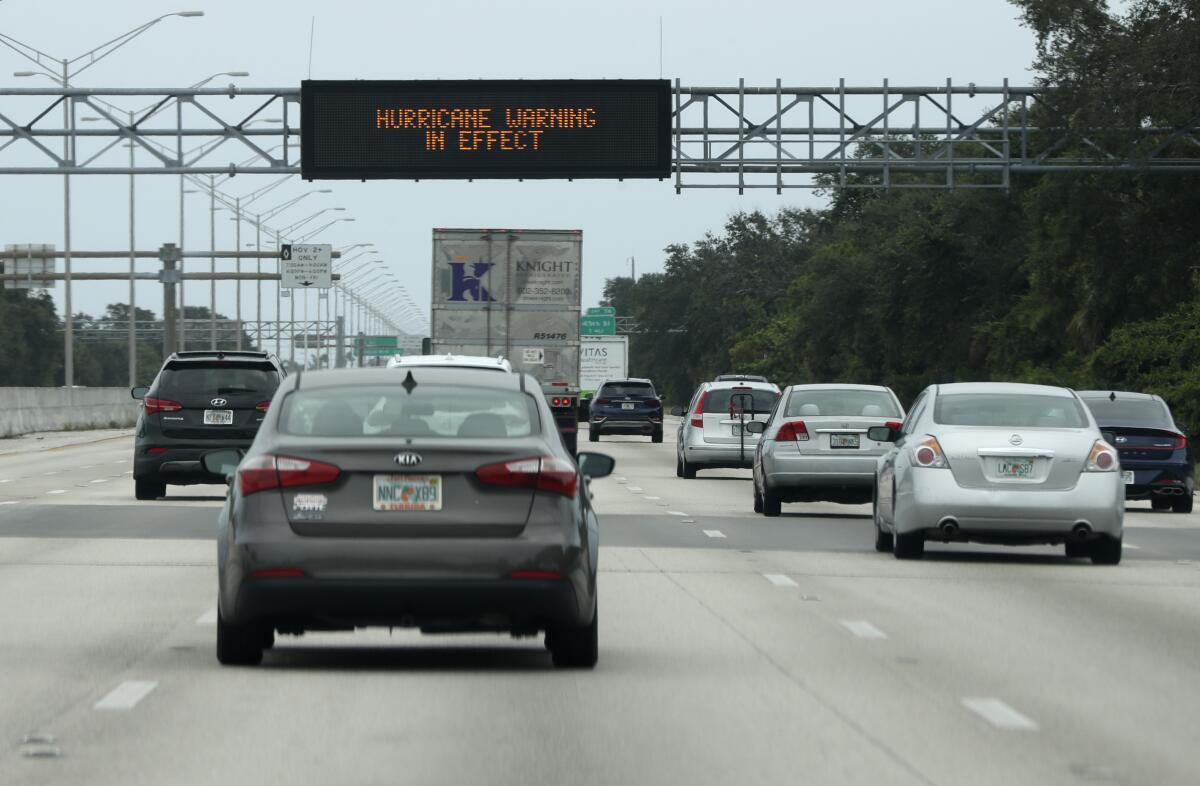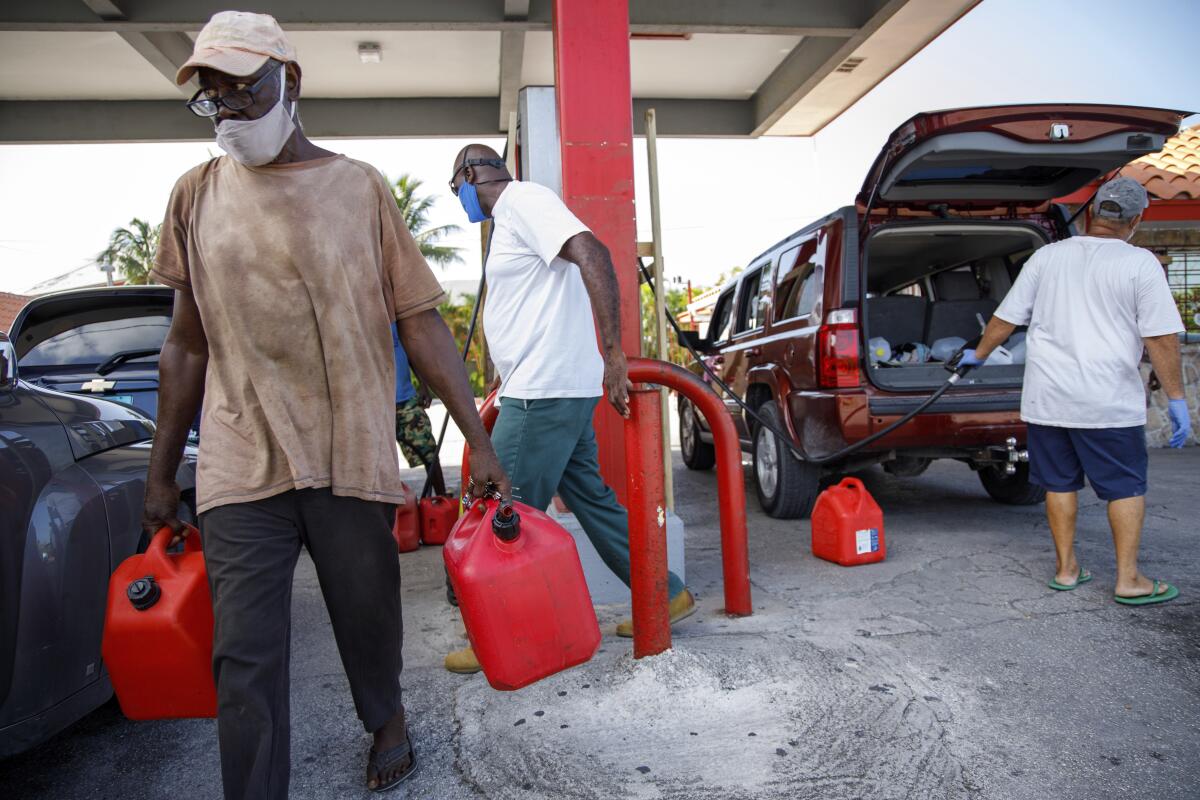Isaias weakens to a tropical storm, but is expected to strengthen on path to virus-hit Florida

- Share via
SAN JUAN, Puerto Rico — Isaias snapped trees and knocked out power as the storm blew through the Bahamas on Saturday and headed toward the Florida coast, threatening to complicate efforts to contain the coronavirus in places where cases are surging.
Isaias weakened from a hurricane to a tropical storm Saturday afternoon, but was expected to regain hurricane strength overnight as it barrels toward Florida.
“We’ll start seeing impacts tonight,” Florida Gov. Ron DeSantis warned during a news conference. “Don’t be fooled by the downgrade.”
Isaias is piling another burden on communities already hard-hit by other storms and sickness.
Florida authorities closed beaches, parks and virus testing sites, lashing signs to palm trees so they won’t blow away. The governor said the state is anticipating power outages and asked residents to have a week’s supply of water, food and medicine on hand. Officials wrestled with how to prepare shelters where people can seek refuge from the storm if necessary, while safely social distancing to prevent the spread of the virus.
Authorities in North Carolina ordered the evacuation of Ocracoke Island, which was slammed by last year’s Hurricane Dorian, starting Saturday evening. Meanwhile, officials in the Bahamas cleared people out of the Abaco Islands who have been living in temporary structures since Dorian devastated the area, killing at least 70 people.

Isaias’ maximum sustained winds declined steadily throughout Saturday, and were near 70 mph around 8 p.m. Eastern time, hours after the U.S. National Hurricane Center downgraded its status. It said Isaias would regain hurricane strengthen by early Sunday.
By Saturday evening, the storm was about 100 miles southeast of Fort Lauderdale, Fla. It was moving northwest at 9 mph and expected to be near Florida’s southeast coast early Sunday, then tack near or along the state’s Atlantic coast during the day.
Isaias is expected to remain a hurricane through Monday, then slowly weaken on its climb up the Atlantic seaboard. It’s expected to move off the coast of Georgia en route toward the mid-Atlantic states. Heavy rain, flooding and high winds could batter much of the East Coast during the week.
Despite the approaching storm, NASA says the return of two astronauts aboard a SpaceX capsule is still on track for Sunday afternoon. Doug Hurley and Bob Behnken are preparing to make the first splashdown return in 45 years, after two months docked at the International Space Station. They are aiming for the Gulf of Mexico just off the Florida Panhandle, and flight controllers are keeping close watch on the storm.
Isaias — pronounced ees-ah-EE-ahs — has already been destructive in the Caribbean: On Thursday, before it became a hurricane, it uprooted trees, destroyed crops and homes and caused widespread flooding and small landslides in the Dominican Republic and Puerto Rico. One man died in the Dominican Republic. In Puerto Rico, the National Guard rescued at least 35 people from floodwaters that swept away one woman, whose body was recovered Saturday.
Concerns about the coronavirus and the vulnerability of people who are still recovering from Dorian were adding to worries about the storm.
Bahamian Prime Minister Hubert Minnis relaxed a coronavirus lockdown as a result of the storm, but imposed a 10 p.m. to 5 a.m. curfew. He said supermarkets, pharmacies, gas stations and hardware stores would be open as long as weather permitted.
“The center of COVID-19 now is in Grand Bahama,” the island’s minister, Sen. Kwasi Thompson, told government-run ZNS Bahamas. “No one wanted to see a situation where we are now facing a hurricane.”
The Bahamas has reported more than 570 confirmed COVID-19 cases and at least 14 deaths. It recently barred travelers from the U.S. following a surge in cases after it reopened to international tourism.
As the storm moves toward the southeastern coast of Florida, a hurricane warning is in effect from Boca Raton to the Volusia-Flagler county line, which lies about 150 miles north. A storm surge watch is in effect from Jupiter Inlet to Ponte Vedra Beach.
Coronavirus cases have surged in Florida in recent weeks, and the added menace of a storm ratcheted up the anxiety. State-run virus testing sites are closing in areas where the storm might hit because the sites are outdoor tents.
Natalie Betancur, stocking up at a grocery in Palm Beach Gardens, said the storm itself didn’t cause her great concern. But, she added, “I feel that the public is really panicking because it’s a hurricane and we’re in the middle of a pandemic.”
DeSantis said Saturday that 16 counties have declared states of emergency, although no immediate evacuation orders have been given. He also said that hospitals are not being evacuated of coronavirus patients or others.
Still, the pandemic forced officials to wrestle with social distancing rules at the same time as disaster response.
At one of four shelters in Palm Beach County on Saturday afternoon, people had their temperatures checked at the door before entering. Public buses were taking residents to the shelter as crews work to sanitize the buses between stops.
Kevin Shelton, the owner of Causeway Mowers in Indian Harbour Beach, Fla., said his store has been packed for two days with folks streaming in to buy generators, chain saws and other provisions. On Saturday morning, Shelton and his wife served at least 25 customers an hour, double their normal weekend business.
“We’ve been in the area almost 50 years. We keep an eye on every storm,” he said. “It could shift in this direction at any moment.”
More to Read
Sign up for Essential California
The most important California stories and recommendations in your inbox every morning.
You may occasionally receive promotional content from the Los Angeles Times.












